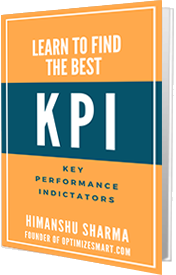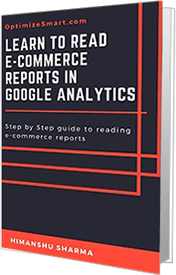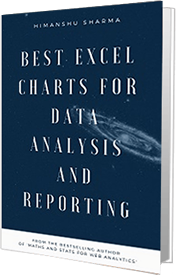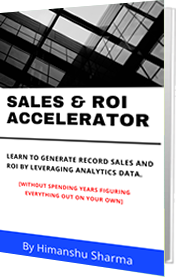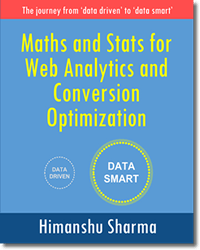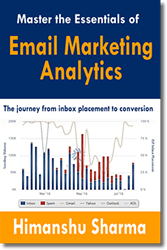Beginners Guide to Ecommerce Analytics – Lifetime Value and Beyond
Last Updated: August 31, 2023
When you track website usage data (sessions, bounce rate, conversion rate, etc) from analytics tools like Google Analytics, you are focusing only on tracking short term gains and impact.
In order to track long term gains and the true value of your marketing and customers, you need to move beyond Google Analytics and spend time in calculating and monitoring, not just one but many ecommerce analytics metrics like:
- Customer Lifetime Value
- Customer Profitability Score
- Retention Rate
- Purchase frequency
- Net Promoter Score etc.
Once you have passed the start-up stage, it is important that you think long term and focus on acquiring customers, that create long term value for your company.
Through ecommerce analytics metrics, you can get answers to questions like:
# Who are my best customers?
# Am I spending enough to acquire the best customers from each marketing channel?
# Is my ‘cost per acquisition’ calculation accurate?
# Do I really need to focus on building user engagement and brand loyalty for my business?
# Am I am spending more, on acquiring a large number of low-value customers instead of a few high-value customers?
# What is the lasting impact of acquiring low-value customers, on the business bottomline?
# Which customers are more likely to buy again and hence should be retargeted?
# Who are my most important retargeting audience?
# Who are my least important retargeting audience?
It is important to remember that, there is no one size fit all definition or formula for calculating various ecommerce analytics metrics mentioned in this article.
The definition and formulas can vary greatly among products, services, business models, sales cycles, customer personas, industries, etc. For example, a subscription-based ecommerce business can compute customer lifetime value very differently than a non-subscription based ecommerce business.
Similarly, among subscription-based businesses, the one which has got multiple product lines is going to compute lifetime value very differently than the subscription-based business which has got only one product line.
The main objective of this article is to introduce you to various ecommerce analytics metrics available.
Once you are familiar with them, feel free to use them in a way, that best fits with your business model, product, or service.
Customer Lifetime Value
With ever-increasing competition and market saturation, customer acquisition is becoming more and more difficult, and expensive.
Therefore it has become more important than ever, to focus on acquiring, only the best customers, the ones which are profitable, both in the short term and long term.
In the context of acquisition, the ‘customer lifetime value’ metrics is very important, as it helps in truly understanding and optimizing the performance of your acquisition strategy.
Customer lifetime value is the projected revenue (sales), a person may generate during his/her lifetime, as a customer, for your business.
Different types of customers (customers personas) have different lifetime value (LTV).
Customer Lifetime Value = average order value X number of repeat orders X average customer life span
Here, average customer life span refers to, how long a person remains your customer. The life span can be measured in number of days, weeks, months, or years.
One of the best ways to increase LTV is by improving customers’ satisfaction and retention.
Related Article: Measuring Customers lifetime value in Google Analytics for Mobile App and Website users
Cost Per Acquisition(CPA)
Cost Per Acquisition (CPA) is the average initial cost of acquiring a customer.
Cost per acquisition = total initial cost of acquiring customers / total unique customers acquired in a given time period.
The CPA decreases over time, once the customer starts making repeat purchases.
So in order to determine your true cost per acquisition, you need to calculate the customer’s lifetime value.
Related Article: 12 guaranteed methods to reduce cost per acquisition.
Customer Profitability Score
This score is used to separate profitable customers from unprofitable customers and is a much more important metric than ‘lifetime value’, as it takes ‘cost’ into account.
You can calculate this score for each individual customer or for each individual customer’s persona.
Customer profitability score =
Revenue earned through the customer in a given time period
+ Projected revenue customer will generate during his lifetime (LTV value)
– Average cost of acquiring a customer (CPA)
– Average cost associated with customer’s management, retention or service during his lifetime.
Note: Instead of average costs, you can also separately calculate and use, the ‘total cost’ associated with each individual customer. But I don’t find that very practical, especially for a large number of customers.
You need to calculate and monitor customer profitability scores at least once a month, as it may increase or decrease over time.
For example, if there is a sharp increase in the cost associated with customer management, over time your profitability score, will go down. This is especially true in the case of the service industry and SAAS businesses.
Your customer profitability score can also go down to the point, where your customer is no longer profitable for you, as the cost associated with customer’s management, retention or service has exceeded (or is projected to exceed) far more than the sum of ‘Revenue earned through the customer so far’ and his lifetime value.
Therefore it is critical that you calculate and monitor customer profitability score for each individual customer or customer persona esp. if you are in the service industry or run a subscription-based ecommerce business.
Customer sales cycle length
It is the average time (measured in days, weeks, months, and sometimes years) it takes, for a person/website visitor, to turn into your customer.
Customer sales cycle length can vary greatly, among products, services, businesses, and industries.
Some purchases (like buying a car/house) require much more consideration and research than other purchases (like buying a pint of milk).
However, by shortening your sales cycle, you can greatly reduce your cost per acquisition and can also increase customer lifetime value and profitability score.
One of the best ways, to shorten the sales cycle is by focusing only on acquiring high-value customers, the ones which are most profitable and the ones which are most likely to convert.
Not all prospects will turn into customers.
So it is important that you focus on streamlining your “qualified customer’ criteria” and disqualify low-value customers, as early as possible, in your sales process.
Remember, low-value customers, the ones who don’t understand the value of your product/service, the ones who are hard to please, the ones who don’t believe in your solution, are also the ones who ask a lot more questions, required a lot more convincing, demand discounts, trials, take a long time to make a purchase decision and are thus, also the ones, who create long sales cycle.
These low-value customers not only create a long sales cycle, but they also increase your customer acquisition and ongoing customer management cost.
They may add value to your business in the short term (through increased sales) but they are least likely to stick around, least likely to promote your brand and are also least likely to be profitable in the long run.
Product lifespan
Product lifespan is the average duration (measured in days, weeks, months, or years), for which a product remains useful/consumable.
Product life span can vary greatly, among products. For example, fast-moving consumer goods (like bread, sandwich, etc) have a very short lifespan and short sales cycle, then the goods with a longer lifespan like cars, refrigerators, houses, etc.
Product lifespan plays an important role in creating your marketing and pricing strategies.
The shorter your product lifespan, the more meaningful, customers retention becomes, as you want your customers to remain loyal to your brand and keep coming back, to buy more items.
On the contrary, the longer the product life span, the less meaningful, customers retention becomes, as people won’t make a repeat purchase any time soon, no matter how you re-target them.
For example, if you sell swimming pools, cars or houses, then spending time and money on improving customer retention, is not that useful, as you don’t expect repeat business any time soon.
Product lifespan also impacts your pricing strategy. Products with a short lifespan (like food items, greeting cards etc) can be easily produced and sold, and thus have far more supply than demand, which increases the competition and tend to lower the product price.
What that means, if you sell a product with a short lifespan, you need to bid much more aggressively on your ads. You need to spend, way lot more on advertising and remarketing campaigns, just to remain in business.
On top of that, you may be forced to operate on low-profit margins (as market won’t pay if the cost is high) and thus, you are also forced to sell in huge volume, to remain profitable.
Even a small decline in sales can quickly erase your profits and can result in a net loss.
Customer Return Rate
It is the rate at which customers return to your website/business to make a purchase in a given time period.
Customers return rate = Total number of customers that have placed more the one order (transaction) in a given time period / Total number of unique customers acquired during the same time period.
For example, if 150 customers placed more than one order in the last one month and you acquired 500 unique customers during that month then
Customers Returning Rate = 150 / 500 * 100 = 30%
You can improve customers returning rate, by running remarketing campaigns.
The shorter your product lifespan, the more meaningful, customers returning rate becomes.
For example, if you sell Fast Moving Consumer Goods (like milk, vegetables, alcohol, etc), you would expect your customers to shop very frequently.
On the other hand, if your product life is long, like you sell cars or furniture, you can’t expect your customers to return every month or even every year to make a purchase.
Purchase frequency
It is the rate at which customers make a purchase on your website in a given time period.
Purchase frequency = total orders placed in a given time period / total unique customers acquired during the same time period.
For example, if 1000 orders were placed in the last one month and you acquired 500 unique customers during that month then,
Purchase frequency = 1000 / 500 = 2
You can increase purchase frequency by:
#1 creating and promoting limited-time offers through remarketing campaigns.
#2 frequently engaging with your customers on social media and via newsletters.
#3 developing loyalty and rewards programs.
Customers Retention Rate
This metric is used to determine, how good your business is in, retaining customers.
Customer Retention Rate = [1- (Customers lost in a given time period/total number of customers acquired in the same time period)] * 100
The shorter your product lifespan/sales cycle, the more meaningful, customer retention rate becomes. For example, if you sell Fast Moving Consumer Goods, you would expect your customers to shop frequently. For that to happen, you need to make sure your customers stick around with you.
On the other hand, longer your product lifespan or sales cycle, the less meaningful, customer retention rate becomes. For example, if you sell swimming pools, you won’t expect your customer to return any time soon. So there is no point, in spending time and money on improving customer retention rates.
Customer retention rate is very important for businesses, who sell services and who expect repeat business from the same client. This metric is also useful for SAAS businesses.
You can increase customer retention rate by:
#1 constantly being in touch with your customers through social media, newsletters, blogs, etc with the aim to keep them engaged and happy.
#2 by providing outstanding after-sales service.
#3 by developing loyalty and reward programs.
#4 by building a highly personalized customer experience.
#5 by providing patronage discounts and offers (the ones which are available only to existing customers).
#6 through remarketing campaigns.
Monthly Recurring Revenue (MRR)
MRR is the total revenue a company expects to generate on a monthly basis.
MRR is a very important metric for measuring the growth of a SAAS company. If you are a SAAS business, you should aim to increase your MRR over time.
Monthly Recurring Revenue = total number of paying subscribers X average order value
You can increase MRR by reducing customer churn rate and by increasing average order value. You can increase average order value by selling upgrades to existing customers
Note: You can also calculate MRR for non-subscription based ecommerce businesses.
Customers churn rate
Customers churn rate (also called attrition rate) is the percentage of customers lost in a given time period.
It is used to determine, how good your business/product/service is at retaining customers. The lower the customer churn rate, the better it is, for your business health.
Customers churn rate = number of customers lost during a given time period / total number of customers you had at the beginning of the same time period.
For example, if your company had 250 customers at the beginning of the last month and 170 of those customers remained with your business, at the end of the last month then your
Customer churn rate = (250 – 170) / 250 = 0.32 or 32%
Note: Customers churn rate calculation, does not take into account, the number of new customers acquired in a given time period.
It only takes into account, the existing customers in a given time period.
MRR churn rate
Monthly recurring revenue churn rate or MRR churn rate is the percentage of monthly recurring revenue lost.
MRR churn rate = ( (MRR at the beginning of a month – MRR at the end of the month) – additional revenue from existing subscribers) ) / MRR at the beginning of the month
Note: In MRR churn rate calculation, you do not take into account, additional revenue generated in a given time period from existing subscribers. This additional revenue can come in the form of upgrades or some other up-sell/cross-sell.
For example, if your:
MRR at the beginning of the last month was: $50,000
MRR at the end of the last month was: $40,000
Additional revenue from existing subscribers was: $1000
Then:
MRR churn rate = ( ($50,000 – $40,000) – $1000)) / $50,000 = 18%
Note: If the churn rate turned out to be negative, then it means, you actually gained MRR. You can also calculate MRR for non-subscription based businesses. However, the calculation is going to be different.
Net promoter Score (NPS)
Net Promoter Score tells you, how likely, it is that your customers will recommend your business to a friend or colleague.
To calculate the net promoter score, ask your customers the following question:
“ On the scale of 1 to 10, how likely is it, that you would recommend our business to your friend or colleague”
Group the respondents into the following three categories, on the basis of their score:
#1 Promoters – customers who gave you a score of 9 or 10. These are the customers who are most likely to recommend your business.
#2 Passives – customers who gave you a score of 7 or 8. These customers are satisfied but not very keen to recommend your business.
#3 Detractors – customers who score your business 0 to 6. These customers have the potential to damage your brand, through negative feedback/reviews.
Net promoter score = % of promoters – % of detractors
To learn more about net promoter score, check out this article: https://www.netpromoter.com/know/
Understanding different customers persona
The whole point of calculating the various ecommerce analytics metrics is to:
- Identify and effectively target different customers persona.
- To separate high-value customers from low-value customers.
- To spend more on acquiring the best customers.
- To spend less on acquiring and retaining low-value customers
Therefore it is very important to identify and define different customers persona for your ecommerce business.
These customers persona could be:
#1 High-value frequent customers
These are the people who frequently spend much more than the average order value and/or frequently buy, very high priced items on your website. These are your most profitable customers.
Say, for example, you run an airline company then your most profitable customers would be first-class frequent flyers i.e. the people who frequently use your airline and almost always travel first class.
#2 High value repeat customers
These are the people who spend much more than the average order value and/or buy very high priced items on your website but they do not purchase frequently.
These could be your second most profitable customers.
So if you run an airline company, then your high-value repeat customers would be, those people who almost always travel first class but they do not use your airline very often.
If you could identify and convert your high-value repeat customers into high-value frequent customers, you can dramatically increase your sales.
#3 Average Frequent Customers
These are the people who frequently purchase items on your website but do not show any particular pattern while making a purchase.
For example, sometimes they purchase a high-value item while other times they purchase a low-value item.
These could be your third most profitable customers.
So if you run an airline company, then your average frequent customers could be, those people who sometimes travel in premium economy, sometimes in economy but no matter which class they travel in, they frequently use your airline.
#4 Average repeat customers
These are the people who purchase items on your website but do not buy very often.
Just like average frequent customers, they do not show any particular pattern while making a high value or low-value purchase.
In the context of the airline business, these are the people who sometimes travel in premium economy, sometimes in economy, and do not use your airline very often.
#5 Low-value frequent customers
These are the people who frequently purchase low-value items on your website.
In the context of the airline business, these are the people who frequently use your airline but almost always travel in economy class.
#6 Low value repeat customers
These are the people who purchase low-value items on your website and do not buy often.
In the context of the airline business, these are the people who almost always travel in economy class and do not use your airline very often.
Only by calculating the various ecommerce analytics metrics, outlined in this article, you can identify such personas for repeat customers.
Only then, you can truly conclude that not all returning customers are the same and you need to treat and re-target them differently.
Last Updated: August 31, 2023
When you track website usage data (sessions, bounce rate, conversion rate, etc) from analytics tools like Google Analytics, you are focusing only on tracking short term gains and impact.
In order to track long term gains and the true value of your marketing and customers, you need to move beyond Google Analytics and spend time in calculating and monitoring, not just one but many ecommerce analytics metrics like:
- Customer Lifetime Value
- Customer Profitability Score
- Retention Rate
- Purchase frequency
- Net Promoter Score etc.
Once you have passed the start-up stage, it is important that you think long term and focus on acquiring customers, that create long term value for your company.
Through ecommerce analytics metrics, you can get answers to questions like:
# Who are my best customers?
# Am I spending enough to acquire the best customers from each marketing channel?
# Is my ‘cost per acquisition’ calculation accurate?
# Do I really need to focus on building user engagement and brand loyalty for my business?
# Am I am spending more, on acquiring a large number of low-value customers instead of a few high-value customers?
# What is the lasting impact of acquiring low-value customers, on the business bottomline?
# Which customers are more likely to buy again and hence should be retargeted?
# Who are my most important retargeting audience?
# Who are my least important retargeting audience?
It is important to remember that, there is no one size fit all definition or formula for calculating various ecommerce analytics metrics mentioned in this article.
The definition and formulas can vary greatly among products, services, business models, sales cycles, customer personas, industries, etc. For example, a subscription-based ecommerce business can compute customer lifetime value very differently than a non-subscription based ecommerce business.
Similarly, among subscription-based businesses, the one which has got multiple product lines is going to compute lifetime value very differently than the subscription-based business which has got only one product line.
The main objective of this article is to introduce you to various ecommerce analytics metrics available.
Once you are familiar with them, feel free to use them in a way, that best fits with your business model, product, or service.
Customer Lifetime Value
With ever-increasing competition and market saturation, customer acquisition is becoming more and more difficult, and expensive.
Therefore it has become more important than ever, to focus on acquiring, only the best customers, the ones which are profitable, both in the short term and long term.
In the context of acquisition, the ‘customer lifetime value’ metrics is very important, as it helps in truly understanding and optimizing the performance of your acquisition strategy.
Customer lifetime value is the projected revenue (sales), a person may generate during his/her lifetime, as a customer, for your business.
Different types of customers (customers personas) have different lifetime value (LTV).
Customer Lifetime Value = average order value X number of repeat orders X average customer life span
Here, average customer life span refers to, how long a person remains your customer. The life span can be measured in number of days, weeks, months, or years.
One of the best ways to increase LTV is by improving customers’ satisfaction and retention.
Related Article: Measuring Customers lifetime value in Google Analytics for Mobile App and Website users
Cost Per Acquisition(CPA)
Cost Per Acquisition (CPA) is the average initial cost of acquiring a customer.
Cost per acquisition = total initial cost of acquiring customers / total unique customers acquired in a given time period.
The CPA decreases over time, once the customer starts making repeat purchases.
So in order to determine your true cost per acquisition, you need to calculate the customer’s lifetime value.
Related Article: 12 guaranteed methods to reduce cost per acquisition.
Customer Profitability Score
This score is used to separate profitable customers from unprofitable customers and is a much more important metric than ‘lifetime value’, as it takes ‘cost’ into account.
You can calculate this score for each individual customer or for each individual customer’s persona.
Customer profitability score =
Revenue earned through the customer in a given time period
+ Projected revenue customer will generate during his lifetime (LTV value)
– Average cost of acquiring a customer (CPA)
– Average cost associated with customer’s management, retention or service during his lifetime.
Note: Instead of average costs, you can also separately calculate and use, the ‘total cost’ associated with each individual customer. But I don’t find that very practical, especially for a large number of customers.
You need to calculate and monitor customer profitability scores at least once a month, as it may increase or decrease over time.
For example, if there is a sharp increase in the cost associated with customer management, over time your profitability score, will go down. This is especially true in the case of the service industry and SAAS businesses.
Your customer profitability score can also go down to the point, where your customer is no longer profitable for you, as the cost associated with customer’s management, retention or service has exceeded (or is projected to exceed) far more than the sum of ‘Revenue earned through the customer so far’ and his lifetime value.
Therefore it is critical that you calculate and monitor customer profitability score for each individual customer or customer persona esp. if you are in the service industry or run a subscription-based ecommerce business.
Customer sales cycle length
It is the average time (measured in days, weeks, months, and sometimes years) it takes, for a person/website visitor, to turn into your customer.
Customer sales cycle length can vary greatly, among products, services, businesses, and industries.
Some purchases (like buying a car/house) require much more consideration and research than other purchases (like buying a pint of milk).
However, by shortening your sales cycle, you can greatly reduce your cost per acquisition and can also increase customer lifetime value and profitability score.
One of the best ways, to shorten the sales cycle is by focusing only on acquiring high-value customers, the ones which are most profitable and the ones which are most likely to convert.
Not all prospects will turn into customers.
So it is important that you focus on streamlining your “qualified customer’ criteria” and disqualify low-value customers, as early as possible, in your sales process.
Remember, low-value customers, the ones who don’t understand the value of your product/service, the ones who are hard to please, the ones who don’t believe in your solution, are also the ones who ask a lot more questions, required a lot more convincing, demand discounts, trials, take a long time to make a purchase decision and are thus, also the ones, who create long sales cycle.
These low-value customers not only create a long sales cycle, but they also increase your customer acquisition and ongoing customer management cost.
They may add value to your business in the short term (through increased sales) but they are least likely to stick around, least likely to promote your brand and are also least likely to be profitable in the long run.
Product lifespan
Product lifespan is the average duration (measured in days, weeks, months, or years), for which a product remains useful/consumable.
Product life span can vary greatly, among products. For example, fast-moving consumer goods (like bread, sandwich, etc) have a very short lifespan and short sales cycle, then the goods with a longer lifespan like cars, refrigerators, houses, etc.
Product lifespan plays an important role in creating your marketing and pricing strategies.
The shorter your product lifespan, the more meaningful, customers retention becomes, as you want your customers to remain loyal to your brand and keep coming back, to buy more items.
On the contrary, the longer the product life span, the less meaningful, customers retention becomes, as people won’t make a repeat purchase any time soon, no matter how you re-target them.
For example, if you sell swimming pools, cars or houses, then spending time and money on improving customer retention, is not that useful, as you don’t expect repeat business any time soon.
Product lifespan also impacts your pricing strategy. Products with a short lifespan (like food items, greeting cards etc) can be easily produced and sold, and thus have far more supply than demand, which increases the competition and tend to lower the product price.
What that means, if you sell a product with a short lifespan, you need to bid much more aggressively on your ads. You need to spend, way lot more on advertising and remarketing campaigns, just to remain in business.
On top of that, you may be forced to operate on low-profit margins (as market won’t pay if the cost is high) and thus, you are also forced to sell in huge volume, to remain profitable.
Even a small decline in sales can quickly erase your profits and can result in a net loss.
Customer Return Rate
It is the rate at which customers return to your website/business to make a purchase in a given time period.
Customers return rate = Total number of customers that have placed more the one order (transaction) in a given time period / Total number of unique customers acquired during the same time period.
For example, if 150 customers placed more than one order in the last one month and you acquired 500 unique customers during that month then
Customers Returning Rate = 150 / 500 * 100 = 30%
You can improve customers returning rate, by running remarketing campaigns.
The shorter your product lifespan, the more meaningful, customers returning rate becomes.
For example, if you sell Fast Moving Consumer Goods (like milk, vegetables, alcohol, etc), you would expect your customers to shop very frequently.
On the other hand, if your product life is long, like you sell cars or furniture, you can’t expect your customers to return every month or even every year to make a purchase.
Purchase frequency
It is the rate at which customers make a purchase on your website in a given time period.
Purchase frequency = total orders placed in a given time period / total unique customers acquired during the same time period.
For example, if 1000 orders were placed in the last one month and you acquired 500 unique customers during that month then,
Purchase frequency = 1000 / 500 = 2
You can increase purchase frequency by:
#1 creating and promoting limited-time offers through remarketing campaigns.
#2 frequently engaging with your customers on social media and via newsletters.
#3 developing loyalty and rewards programs.
Customers Retention Rate
This metric is used to determine, how good your business is in, retaining customers.
Customer Retention Rate = [1- (Customers lost in a given time period/total number of customers acquired in the same time period)] * 100
The shorter your product lifespan/sales cycle, the more meaningful, customer retention rate becomes. For example, if you sell Fast Moving Consumer Goods, you would expect your customers to shop frequently. For that to happen, you need to make sure your customers stick around with you.
On the other hand, longer your product lifespan or sales cycle, the less meaningful, customer retention rate becomes. For example, if you sell swimming pools, you won’t expect your customer to return any time soon. So there is no point, in spending time and money on improving customer retention rates.
Customer retention rate is very important for businesses, who sell services and who expect repeat business from the same client. This metric is also useful for SAAS businesses.
You can increase customer retention rate by:
#1 constantly being in touch with your customers through social media, newsletters, blogs, etc with the aim to keep them engaged and happy.
#2 by providing outstanding after-sales service.
#3 by developing loyalty and reward programs.
#4 by building a highly personalized customer experience.
#5 by providing patronage discounts and offers (the ones which are available only to existing customers).
#6 through remarketing campaigns.
Monthly Recurring Revenue (MRR)
MRR is the total revenue a company expects to generate on a monthly basis.
MRR is a very important metric for measuring the growth of a SAAS company. If you are a SAAS business, you should aim to increase your MRR over time.
Monthly Recurring Revenue = total number of paying subscribers X average order value
You can increase MRR by reducing customer churn rate and by increasing average order value. You can increase average order value by selling upgrades to existing customers
Note: You can also calculate MRR for non-subscription based ecommerce businesses.
Customers churn rate
Customers churn rate (also called attrition rate) is the percentage of customers lost in a given time period.
It is used to determine, how good your business/product/service is at retaining customers. The lower the customer churn rate, the better it is, for your business health.
Customers churn rate = number of customers lost during a given time period / total number of customers you had at the beginning of the same time period.
For example, if your company had 250 customers at the beginning of the last month and 170 of those customers remained with your business, at the end of the last month then your
Customer churn rate = (250 – 170) / 250 = 0.32 or 32%
Note: Customers churn rate calculation, does not take into account, the number of new customers acquired in a given time period.
It only takes into account, the existing customers in a given time period.
MRR churn rate
Monthly recurring revenue churn rate or MRR churn rate is the percentage of monthly recurring revenue lost.
MRR churn rate = ( (MRR at the beginning of a month – MRR at the end of the month) – additional revenue from existing subscribers) ) / MRR at the beginning of the month
Note: In MRR churn rate calculation, you do not take into account, additional revenue generated in a given time period from existing subscribers. This additional revenue can come in the form of upgrades or some other up-sell/cross-sell.
For example, if your:
MRR at the beginning of the last month was: $50,000
MRR at the end of the last month was: $40,000
Additional revenue from existing subscribers was: $1000
Then:
MRR churn rate = ( ($50,000 – $40,000) – $1000)) / $50,000 = 18%
Note: If the churn rate turned out to be negative, then it means, you actually gained MRR. You can also calculate MRR for non-subscription based businesses. However, the calculation is going to be different.
Net promoter Score (NPS)
Net Promoter Score tells you, how likely, it is that your customers will recommend your business to a friend or colleague.
To calculate the net promoter score, ask your customers the following question:
“ On the scale of 1 to 10, how likely is it, that you would recommend our business to your friend or colleague”
Group the respondents into the following three categories, on the basis of their score:
#1 Promoters – customers who gave you a score of 9 or 10. These are the customers who are most likely to recommend your business.
#2 Passives – customers who gave you a score of 7 or 8. These customers are satisfied but not very keen to recommend your business.
#3 Detractors – customers who score your business 0 to 6. These customers have the potential to damage your brand, through negative feedback/reviews.
Net promoter score = % of promoters – % of detractors
To learn more about net promoter score, check out this article: https://www.netpromoter.com/know/
Understanding different customers persona
The whole point of calculating the various ecommerce analytics metrics is to:
- Identify and effectively target different customers persona.
- To separate high-value customers from low-value customers.
- To spend more on acquiring the best customers.
- To spend less on acquiring and retaining low-value customers
Therefore it is very important to identify and define different customers persona for your ecommerce business.
These customers persona could be:
#1 High-value frequent customers
These are the people who frequently spend much more than the average order value and/or frequently buy, very high priced items on your website. These are your most profitable customers.
Say, for example, you run an airline company then your most profitable customers would be first-class frequent flyers i.e. the people who frequently use your airline and almost always travel first class.
#2 High value repeat customers
These are the people who spend much more than the average order value and/or buy very high priced items on your website but they do not purchase frequently.
These could be your second most profitable customers.
So if you run an airline company, then your high-value repeat customers would be, those people who almost always travel first class but they do not use your airline very often.
If you could identify and convert your high-value repeat customers into high-value frequent customers, you can dramatically increase your sales.
#3 Average Frequent Customers
These are the people who frequently purchase items on your website but do not show any particular pattern while making a purchase.
For example, sometimes they purchase a high-value item while other times they purchase a low-value item.
These could be your third most profitable customers.
So if you run an airline company, then your average frequent customers could be, those people who sometimes travel in premium economy, sometimes in economy but no matter which class they travel in, they frequently use your airline.
#4 Average repeat customers
These are the people who purchase items on your website but do not buy very often.
Just like average frequent customers, they do not show any particular pattern while making a high value or low-value purchase.
In the context of the airline business, these are the people who sometimes travel in premium economy, sometimes in economy, and do not use your airline very often.
#5 Low-value frequent customers
These are the people who frequently purchase low-value items on your website.
In the context of the airline business, these are the people who frequently use your airline but almost always travel in economy class.
#6 Low value repeat customers
These are the people who purchase low-value items on your website and do not buy often.
In the context of the airline business, these are the people who almost always travel in economy class and do not use your airline very often.
Only by calculating the various ecommerce analytics metrics, outlined in this article, you can identify such personas for repeat customers.
Only then, you can truly conclude that not all returning customers are the same and you need to treat and re-target them differently.
My best selling books on Digital Analytics and Conversion Optimization
Maths and Stats for Web Analytics and Conversion Optimization
This expert guide will teach you how to leverage the knowledge of maths and statistics in order to accurately interpret data and take actions, which can quickly improve the bottom-line of your online business.
Master the Essentials of Email Marketing Analytics
This book focuses solely on the ‘analytics’ that power your email marketing optimization program and will help you dramatically reduce your cost per acquisition and increase marketing ROI by tracking the performance of the various KPIs and metrics used for email marketing.
Attribution Modelling in Google Analytics and BeyondSECOND EDITION OUT NOW!
Attribution modelling is the process of determining the most effective marketing channels for investment. This book has been written to help you implement attribution modelling. It will teach you how to leverage the knowledge of attribution modelling in order to allocate marketing budget and understand buying behaviour.
Attribution Modelling in Google Ads and Facebook
This book has been written to help you implement attribution modelling in Google Ads (Google AdWords) and Facebook. It will teach you, how to leverage the knowledge of attribution modelling in order to understand the customer purchasing journey and determine the most effective marketing channels for investment.

